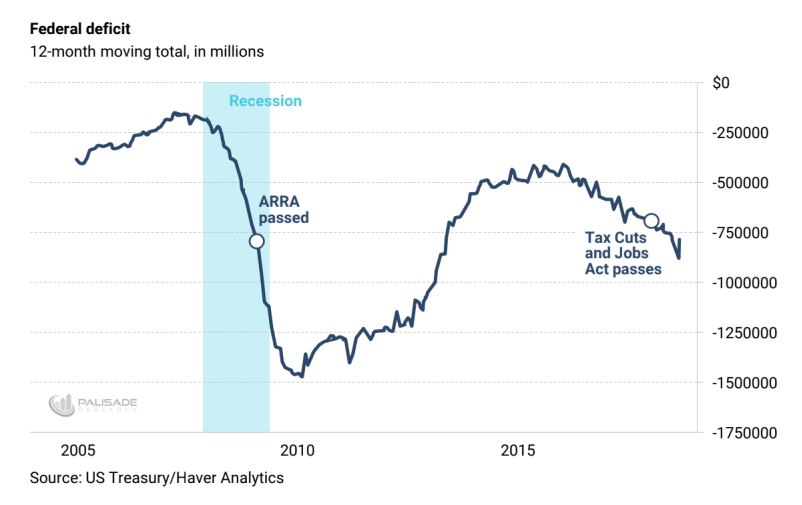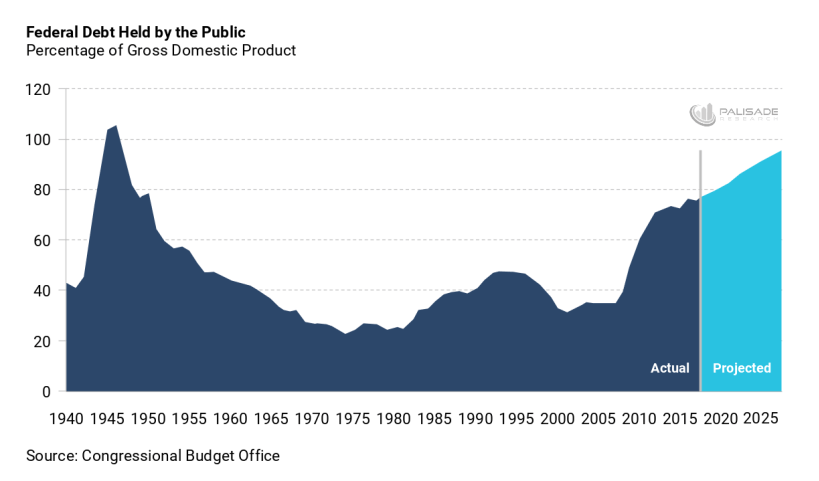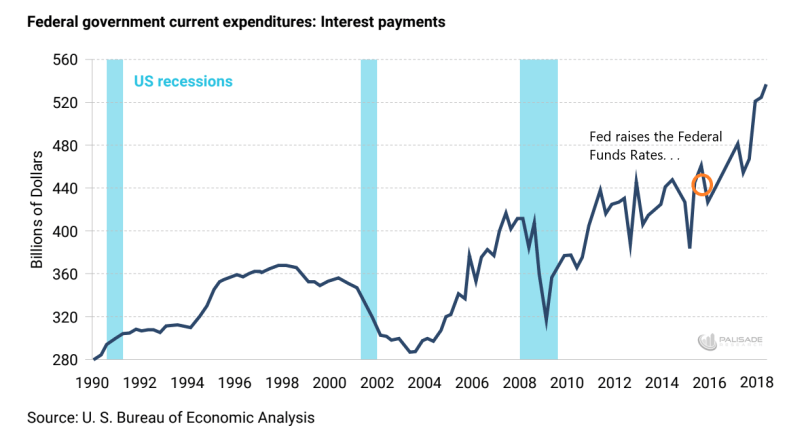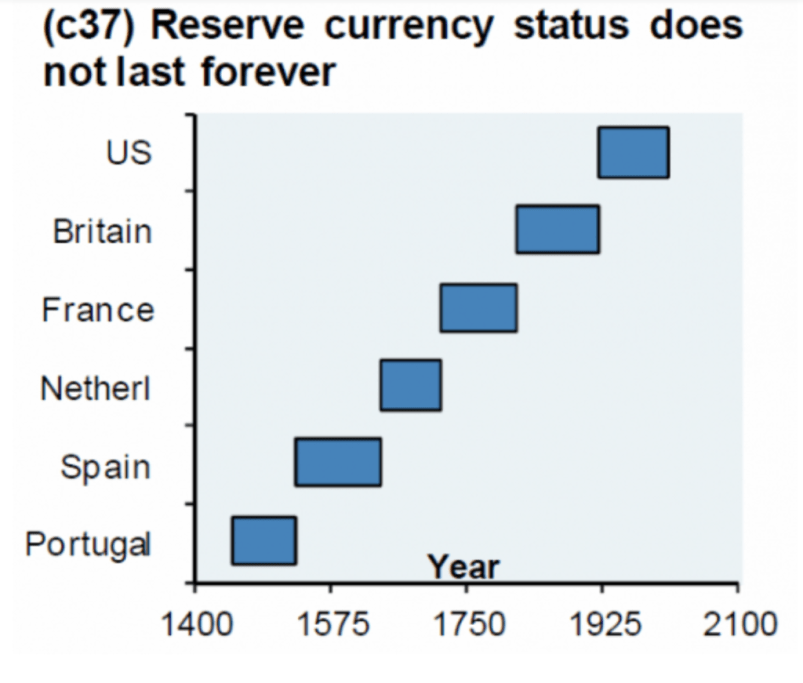If you take a step back and look at the macro picture of the U.S. economy – it resembles a huge, upside-down, glass pyramid.
Constantly teetering back and forth – struggling with everything it has to keep from collapsing.
And so far – it’s done a good job maintaining its balance. But nonetheless, it’s extremely fragile. And gets more so as each day passes by.
All it needs is a slight push in the any direction and down it goes – shattering into pieces. . .
It’s not hard to see that the ever-growing U.S. deficits – along with the soaring interest costs on the National debt – are going to be the focal point of a worldwide crisis.
Especially over the next few years. . .
To start – the U.S. deficit almost eclipsed $800 billion for the entire fiscal year (which ended September 2018) – a 17% year-over-year increase.
And it’s the largest deficit the U.S. has had in six years.
“Hold up – isn’t the economy doing well? Why’s the deficit soaring?”
See – That’s the problem.
The U.S. is borrowing at levels not seen since the direct aftermath of 2008. When the economy was in shambles.
As usual – government spending greatly outpaced revenue.
U.S. Treasury ‘outlays’ (spending) increased $127 billion compared to government ‘receipts’ (income) of only $14 billion.
That’s a $113 billion more than last year’s deficit.
The main causes for the increased deficit was because of Trump’s Tax Cuts (which brought in less federal revenue). And from soaring spending – which came from Defense/Military, as well as Medicaid, Social Security, and Disaster Relief.

It doesn’t look good – does it. But here’s the worst part – things are only going to get worse going forward.
The Congressional Budget Office (CBO) recently published, ‘The 2018 Long-Term Budget Outlook at a Glance’ white paper.
And in it – they project the federal debt to soar over the next few years.

Making things even bleaker – they’re not even accounting for a single recession or slowdown. Thus – if the economy grows slower than their ‘projected average’ – the debt will pile on more. And faster.
But the real issue bothering me with all this is the interest costs for all this debt.
In 2018 – the net interest costs soared to terrifying levels. This happened because of two reasons. . .
First – the deficit (debt) is growing much more than expected.
Second – and most importantly – the Federal Reserve’s raising rates. Which is increasing the interest payments due.
“Interest on the public debt shot up by $65 billion, or 14%, last year, in part because the Treasury had to increase the principal on its inflation-protected securities. Rising interest rates and a bigger debt also played a role.“
You can see that the Fed’s rate hikes (up only two percentage points since December 2015) have significantly increased the interest burden.

In fact – the CBO says. . . “By the end of the projection period [2028], such spending [net interest costs] would almost quadruple as a percentage of GDP and would about equal spending for Social Security, currently the largest federal program.”
At its current rate – according to the CBO – interest due on the national debt will cost over $915 billion per year by 2028.
That’s only nine years from now. . .
How will the U.S. pay cornerstone endeavors – like Social Security, Defense, and Medicare – if all the money goes to paying interest alone?
Putting this into perspective – the U.S. deficit was $775 billion for fiscal year 2018. And at current projections, by 2029, the interest on federal debt – just the interest alone – will cost $915 billion. That’s more than the entire amount the U.S. borrowed this year.
Very soon the U.S. will be borrowing huge amounts of new debt just to simply pay the interest due on old debt (this isn’t even including principle). Most people would call this type of ‘borrowing-to-repay’ a ponzi-scheme. And they wouldn’t be wrong.
All this is why I’ve continued writing about the U.S.’s ever-growing fragility. . .
I wrote about this last January (read here) – and since then things have only worsened.
For starters – the U.S. deficit’s at levels which we haven’t seen since the 2008 recession.
Think about that: if this soaring deficit’s happening all while the U.S. economy’s ‘booming’ – what will it look like during the next recession or mild-slowdown?
For example – imagine you have a friend that’s unemployed and living on credit card debt. He keeps piling up more and more debt and he has no way of ever repaying it.
But his creditors continue to lend – even at very low rates.
Then – a while later – he gets a nice job and his income starts growing.
You think he’ll will stop borrowing and instead start paying back old debts. So that the’ll be able to borrow in case of an emergency later on.
But instead of the credit card debt declining – your friend’s piling on more debt than ever and even faster now.
Even worse – interest rates are also rising.
He tells you, “it’s fine – I have a high paying job, and I’m betting I’ll get raises each year. So I’ll be able to make good on my borrowing.”
But what if he loses his job? What if he doesn’t get those annual raises? He’ll be even worse off now than he was before.
In other words – he’s extremely fragile.
This is what’s going on with the U.S. Treasury. . .
Putting it simply: the U.S. is borrowing debt at crisis levels when its economy is supposedly doing very well. This is the time the deficit should be shrinking. . .
What will happen if a recession hits? In that case – don’t be surprised to see deficits suddenly soar well-over $2 trillion.
There’re many red flags now facing the U.S.
The worst being: the dollar shortage, the tightening Fed, rising inflation, the Chinese currency-trade war, and the disappearance of foreigner creditors willing to lend to the U.S.
Not to mention – thanks to my ‘Bayesian model’ – I think there’s an 85% chance there’s going to be a global earnings recession by late-summer 2019.
All of these things are what I’ve coined The Silent Problem. That’s because the mainstream continues ignoring them.
It’s clear that the U.S. won’t be able to keep up with interest payments.
Paying almost $1 trillion for interest alone will leave the U.S. broke. They won’t have anything left over to pay for other key obligations such Social Security and Medicare.
There’s only one way out of this mess: and that’s for the Fed to cut rates – easing the interest cost burden. And to help ‘monetize’ the U.S. Treasury’s debt burden.
This is when the Fed prints dollars and gives it directly to the Treasury – letting them pay all their obligations.
But expect this to effectively kill the dollar’s reserve status. . .
Don’t think that will happen? It has throughout history – many times.

Each world power and reserve currency ended because of soaring liabilities with no way of ever paying it all back – besides printing money.
I wrote a piece about government defaults recently – you can read that here.
Remember – nine years isn’t that far away.
But expect things to kick off much-earlier than then.
